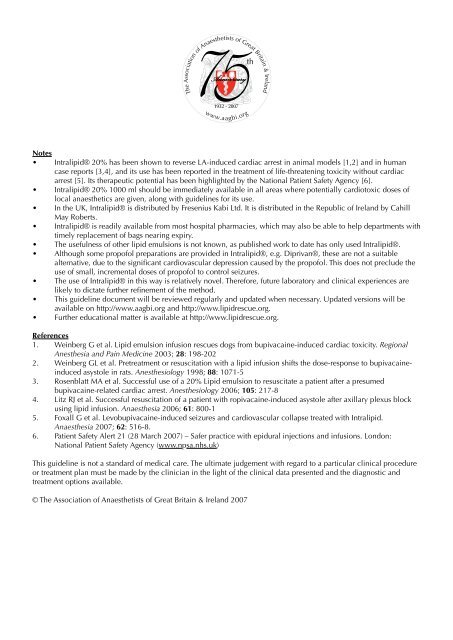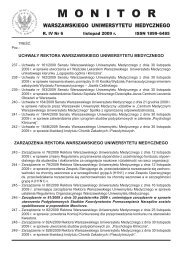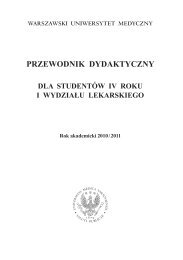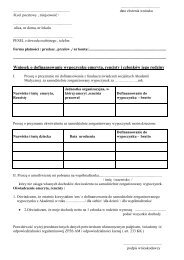Guidelines for the Management of Severe Local Anaesthetic Toxicity ...
Guidelines for the Management of Severe Local Anaesthetic Toxicity ...
Guidelines for the Management of Severe Local Anaesthetic Toxicity ...
- No tags were found...
You also want an ePaper? Increase the reach of your titles
YUMPU automatically turns print PDFs into web optimized ePapers that Google loves.
Notes<br />
• Intralipid® 20% has been shown to reverse LA-induced cardiac arrest in animal models [1,2] and in human<br />
case reports [3,4], and its use has been reported in <strong>the</strong> treatment <strong>of</strong> life-threatening toxicity without cardiac<br />
arrest [5]. Its <strong>the</strong>rapeutic potential has been highlighted by <strong>the</strong> National Patient Safety Agency [6].<br />
• Intralipid® 20% 1000 ml should be immediately available in all areas where potentially cardiotoxic doses <strong>of</strong><br />
local anaes<strong>the</strong>tics are given, along with guidelines <strong>for</strong> its use.<br />
• In <strong>the</strong> UK, Intralipid® is distributed by Fresenius Kabi Ltd. It is distributed in <strong>the</strong> Republic <strong>of</strong> Ireland by Cahill<br />
May Roberts.<br />
• Intralipid® is readily available from most hospital pharmacies, which may also be able to help departments with<br />
timely replacement <strong>of</strong> bags nearing expiry.<br />
• The usefulness <strong>of</strong> o<strong>the</strong>r lipid emulsions is not known, as published work to date has only used Intralipid®.<br />
• Although some prop<strong>of</strong>ol preparations are provided in Intralipid®, e.g. Diprivan®, <strong>the</strong>se are not a suitable<br />
alternative, due to <strong>the</strong> significant cardiovascular depression caused by <strong>the</strong> prop<strong>of</strong>ol. This does not preclude <strong>the</strong><br />
use <strong>of</strong> small, incremental doses <strong>of</strong> prop<strong>of</strong>ol to control seizures.<br />
• The use <strong>of</strong> Intralipid® in this way is relatively novel. There<strong>for</strong>e, future laboratory and clinical experiences are<br />
likely to dictate fur<strong>the</strong>r refinement <strong>of</strong> <strong>the</strong> method.<br />
• This guideline document will be reviewed regularly and updated when necessary. Updated versions will be<br />
available on http://www.aagbi.org and http://www.lipidrescue.org.<br />
• Fur<strong>the</strong>r educational matter is available at http://www.lipidrescue.org.<br />
References<br />
1. Weinberg G et al. Lipid emulsion infusion rescues dogs from bupivacaine-induced cardiac toxicity. Regional<br />
Anes<strong>the</strong>sia and Pain Medicine 2003; 28: 198-202<br />
2. Weinberg GL et al. Pretreatment or resuscitation with a lipid infusion shifts <strong>the</strong> dose-response to bupivacaineinduced<br />
asystole in rats. Anes<strong>the</strong>siology 1998; 88: 1071-5<br />
3. Rosenblatt MA et al. Successful use <strong>of</strong> a 20% Lipid emulsion to resuscitate a patient after a presumed<br />
bupivacaine-related cardiac arrest. Anes<strong>the</strong>siology 2006; 105: 217-8<br />
4. Litz RJ et al. Successful resuscitation <strong>of</strong> a patient with ropivacaine-induced asystole after axillary plexus block<br />
using lipid infusion. Anaes<strong>the</strong>sia 2006; 61: 800-1<br />
5. Foxall G et al. Levobupivacaine-induced seizures and cardiovascular collapse treated with Intralipid.<br />
Anaes<strong>the</strong>sia 2007; 62: 516-8.<br />
6. Patient Safety Alert 21 (28 March 2007) – Safer practice with epidural injections and infusions. London:<br />
National Patient Safety Agency (www.npsa.nhs.uk)<br />
This guideline is not a standard <strong>of</strong> medical care. The ultimate judgement with regard to a particular clinical procedure<br />
or treatment plan must be made by <strong>the</strong> clinician in <strong>the</strong> light <strong>of</strong> <strong>the</strong> clinical data presented and <strong>the</strong> diagnostic and<br />
treatment options available.<br />
© The Association <strong>of</strong> Anaes<strong>the</strong>tists <strong>of</strong> Great Britain & Ireland 2007
















